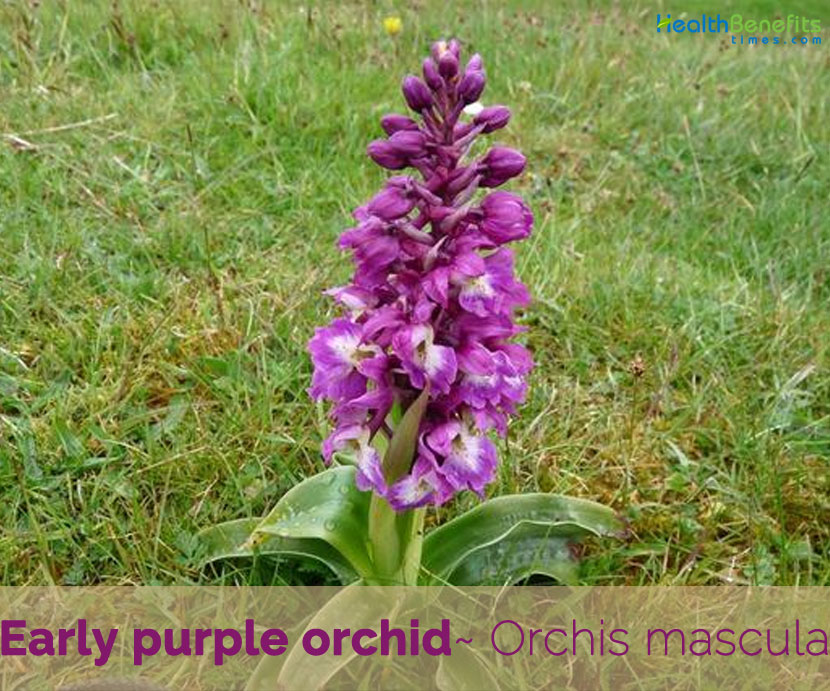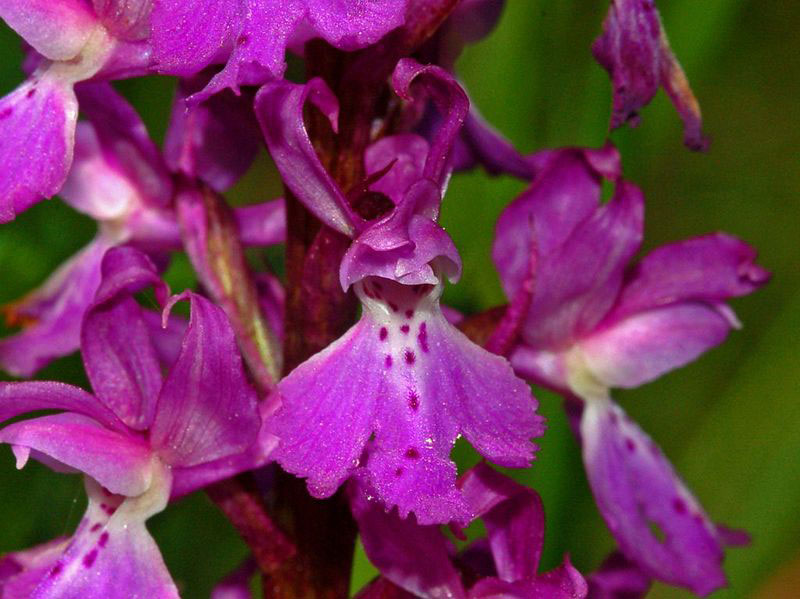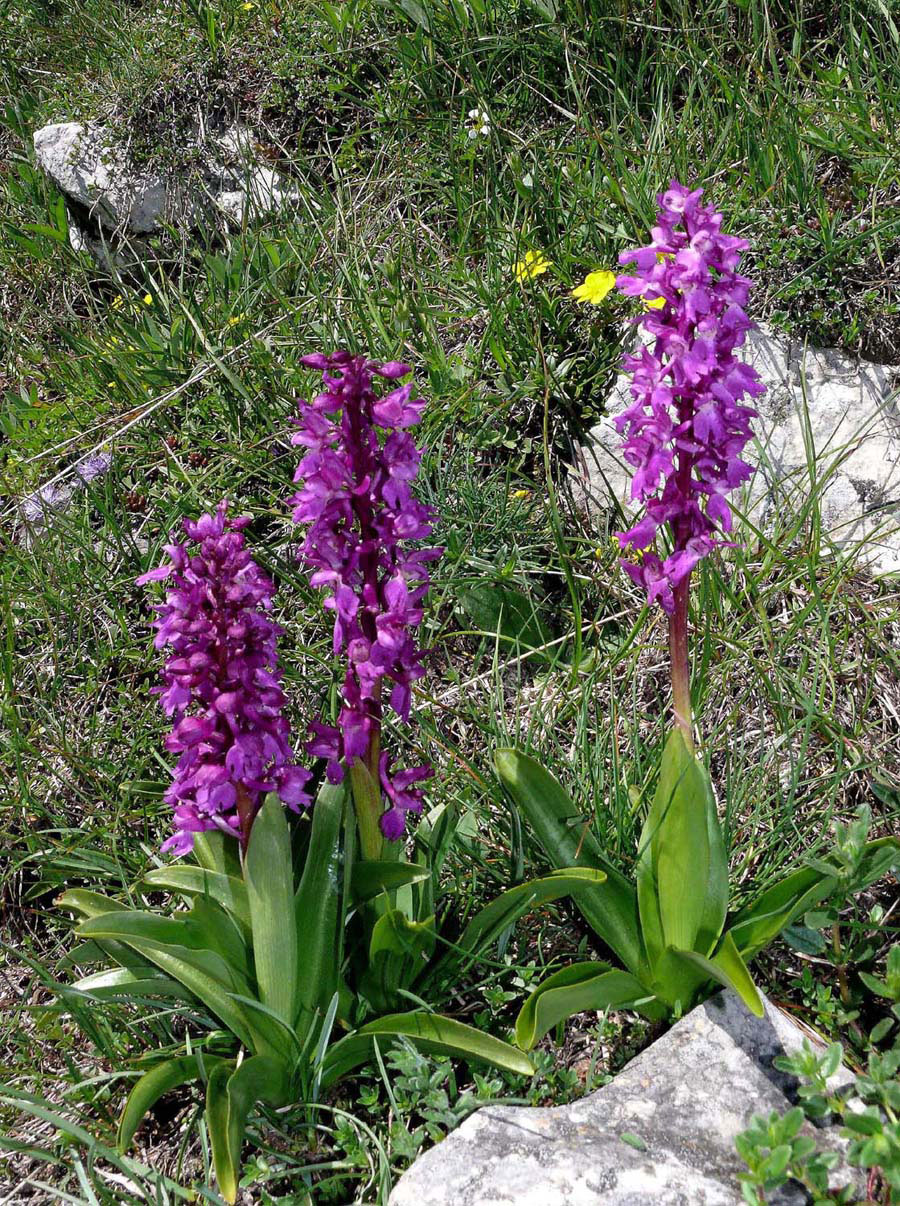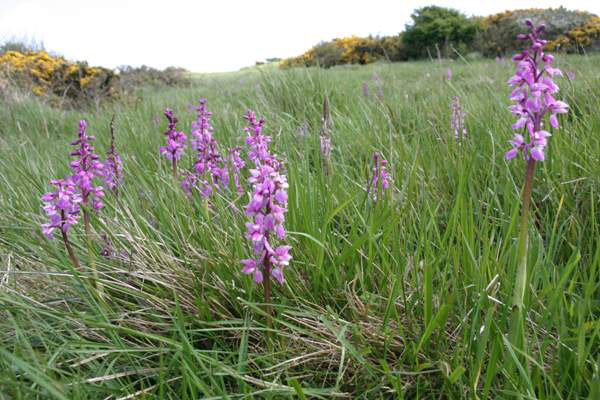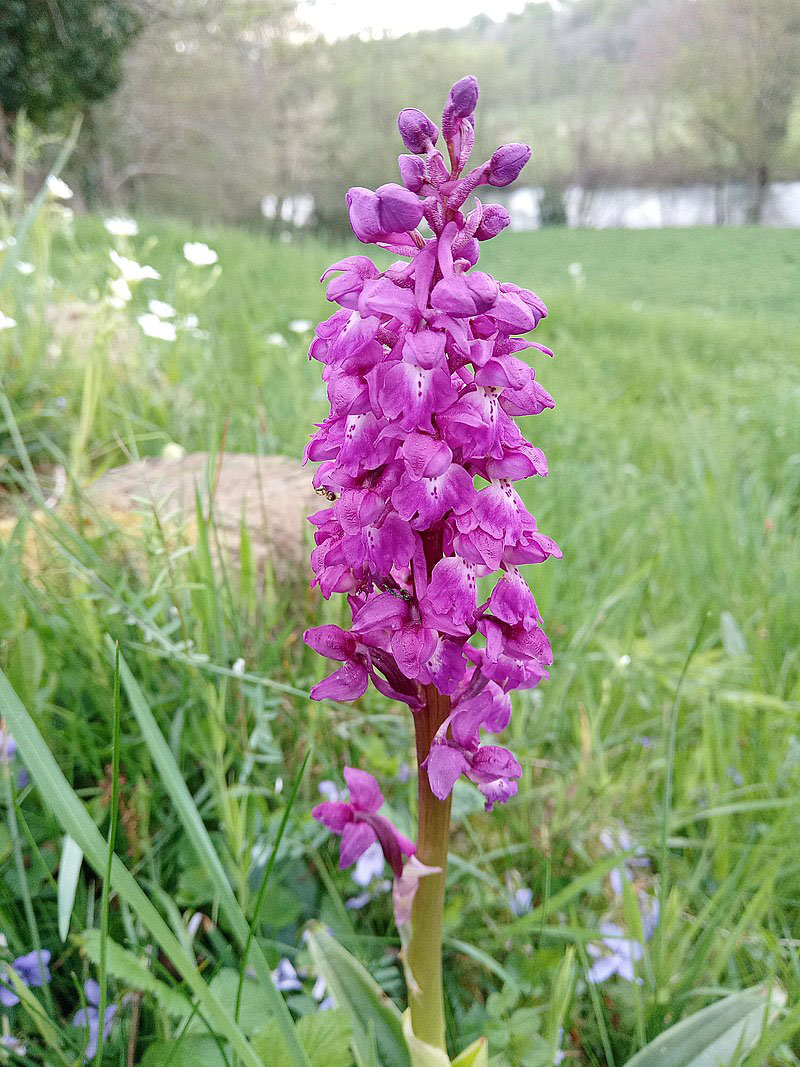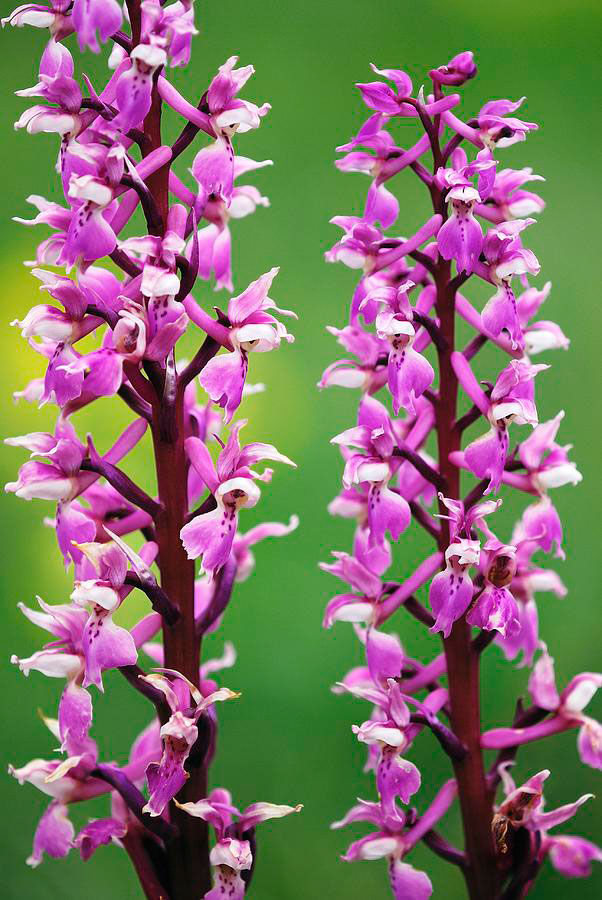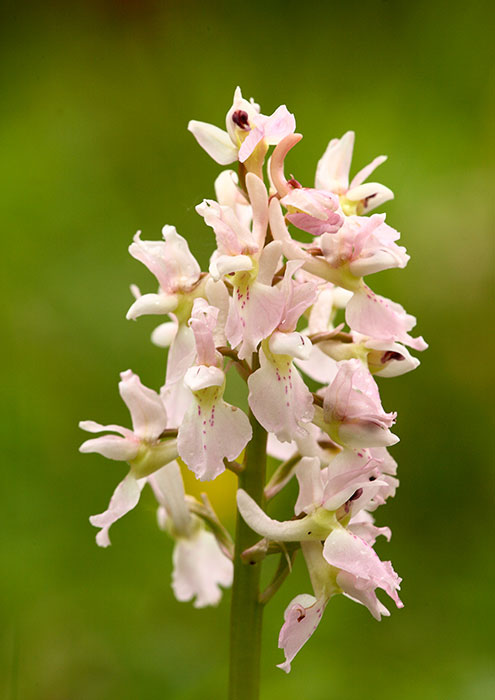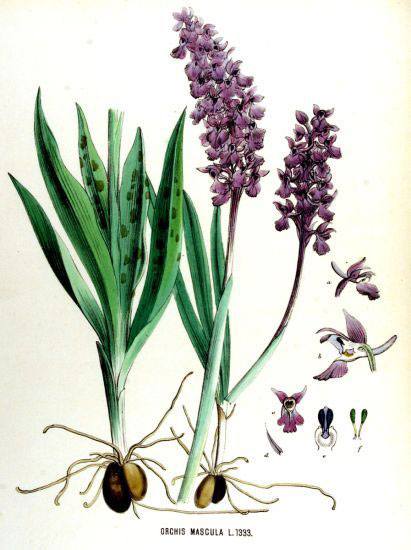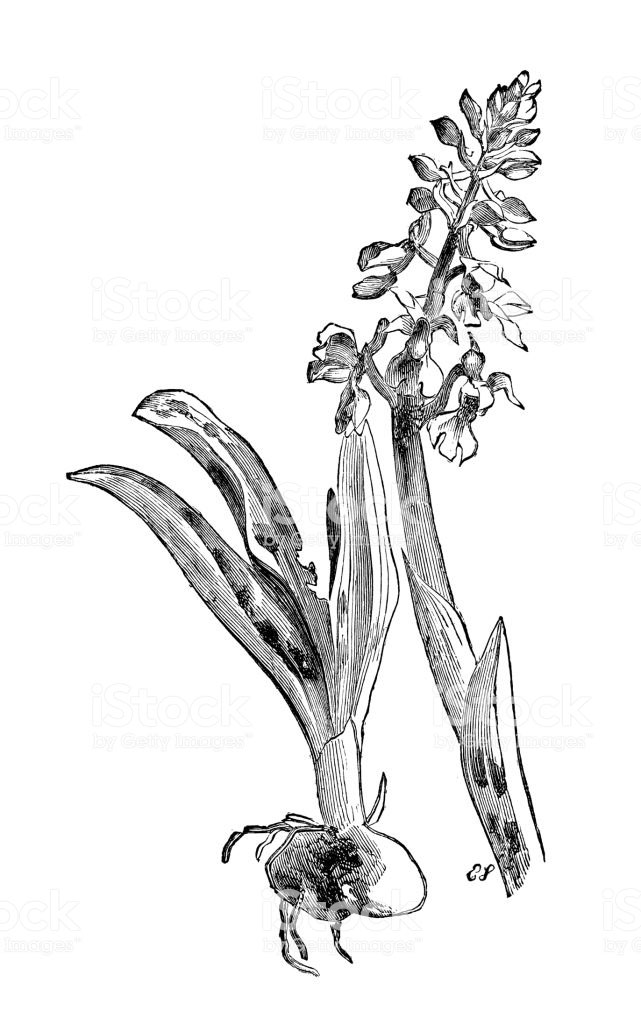Plant Description
Early purple orchid is a perennial herbaceous plant that normally grows about 25–40 cm (10–16 in.) tall. The plant is found growing in woodland, copses, and open pastures in base rich soils, meadows, mountain pastures, woods, coppices and hedgerows. The plant can succeeds in most soils, but it prefers a moist loam and lots of leaf mound. It does best in a deep rich soil. The root system consists of two tubers, rounded or ellipsoid. Perennial stems are green at the base and purple on the apex. 3–4 stalk less leaves are present at base like rosette and alternate sheathing leaves on stem. Blades are elliptic–lanceolate–linear, with entire margin; upper surface is dark green–greyish green, without spots–spotted, spots often large.
Early Purple Orchid Facts
| Early purple orchid Quick Facts | |
|---|---|
| Name: | Early purple orchid |
| Scientific Name: | Orchis mascula |
| Origin | Europe including the British Isles, North-West Africa, the Middle East and western and northern Asia |
| Shapes | Capsule |
| Taste | Sweet |
| Health benefits | Beneficial for treat irritations of the gastro-intestinal canal, inflammation of the Gum and Teeth, cure Erectile Dysfunction and Nightfall. fractured Bones, treat Oligospermia and Oligozoospermia, treats stress and mental disorders |
| Name | Early purple orchid |
|---|---|
| Scientific Name | Orchis mascula |
| Native | Europe including the British Isles, North-West Africa, the Middle East and western and northern Asia |
| Common Names | Early Purple Orchid, salep, blue butcher, clue butcher orchid, male orchid, Salep Orchid, Dead Mans Fingers |
| Name in Other Languages | Albanian: Salep Arabic: Sahalab dhikri (سحلب ذكري) Azerbaijani: Erkək səhləb Bokmal: Vårmarihånd Bulgarian: Mŭzhki salep (мъжки салеп) Catalan: Botonets de gos, Botons de ca, Botons de gos, Lliri de prat, Orquis mascle, Orquídia mascle, satírion tacat Corsican: Orchidea maschili Croatian: Muški kaćun Czech: Vstavač mužský Danish: Tyndakset Gøgeurt De Ch: Männliches Knabenkraut Dutch: Mannetjesorchis, Mannetjeorchis English: Early Purple Orchid, salep, blue butcher, clue butcher orchid, male orchid, Salep Orchid, Dead Mans Fingers, Male Orchis Estonian: Jumalakäpp Finnish: Miehenkämmekkä French: Orchis male, Satyrion male, couillon de chien, mâle fou, pain de couleuvre, pentecôte, satirion, satirion male, soupe à vin German: Männliches Knabenkraut, kleines Knabenkraut, Kuckucksknabenkraut, männliche Orchis, männlicher Harlekin, stattliche Orchis, stattliches Knabenkraut Greek: Órchis i árrin (Όρχις η άρρην) Hindi: Salampanja, salab punja root Hungarian: Füles kosbor Irish: Magairlín meidhreach Italian: Orchidea maschio, giglio caprino, orchide maschia Latvian: Vīru dzegužpuķe Lithuanian: Vyriškoji gegužraibė, Vyriskoji geguzraibe Norwegian: Vårmarihand Persian: Thaealib nar (ثعلب نر) Polish: Storczyk męski Portuguese: Satirião-macho, escroto-canino, pata-de-lobo, salepeira-maior, salepo-maior, satirião-macho Russian: Yatryshnik muzhskoy (Ятрышник мужской) Sanskrit: Salabmisri Serbian: Salep (Салеп) Slovak: Vstavač mužský Slovenian: Stasita kukavica Spanish: Campanos, cañamón, chupaeros, civiles, clavellina, compañón de perro hembra, compañón de perro macho, compañón, lirios, orchismacho, orquídea macho, orquídea Silvestre, sangre de Cristo, satirón, satírion macho, satírion manchado Swedish: Sankt Pers nycklar, Sankt pers nycklar, Miehenkämmekkä, Sankt Pers nyckelblomster Turkish: Er salebi Ukrainian: Zozulynetsʹ cholovichyy (Зозулинець чоловічий), zozulinieć vańkova (зозулинець ванькова) Welsh: Tegeirian coch y gwanwyn |
| Plant Growth Habit | Perennial herbaceous plant |
| Growing Climates | Woodland, copses, open pastures in base rich soils, meadows, mountain pastures, woods, coppices, hedgerows |
| Soil | Succeeds in most soils, but it prefers a moist loam and lots of leaf mould. Requires a deep rich soil |
| Plant Size | 25–40 cm (10–16 in.) |
| Root | Root system consists of two tubers, rounded or ellipsoid |
| Stem | Stems are green at the base and purple on the apex |
| Leaf | 3–4 stalkless leaves at base like rosette and alternate sheathing leaves on stem. Blade elliptic–lanceolate–linear, with entire margin, upper surface dark green–greyish green, without spots–spotted, spots often large |
| Flowering season | Mid-April to mid-June |
| Flower | Flower size is about 2.5 centimeters (1 in) and the color varies from pinkish-purple to purple. The lateral sepals are ovate-lanceolate and erect, the median one, together with the petals, is smaller and cover the gynostegium |
| Fruit Shape & Size | Capsule, that contains tiny like dust seeds |
| Flavor/Aroma | Fairly pleasant odor from a distance, but an unpleasant fur-like smell near |
| Available Forms | Infusion, expressed juice, seeds dried |
| Plant parts Used | Tubers, root |
| Taste | Sweet |
| Culinary Uses |
|
| Other facts |
|
Flowers & Fruits
The inflorescence is 7.5–12.5 centimetres (3–5 in) long and it is composed of 6 to 20 flowers gathered in dense cylindrical spikes. The flower size is about 2.5 centimetres (1 in) and the color varies from pinkish-purple to purple. The lateral sepals are ovate-lanceolate and erect, the median one, together with the petals, is smaller and cover the gynostegium. The labellum is three-lobed and convex, with crenulated margins and the basal part clearer and dotted with purple-brown spots. The spur is cylindrical or clavate, horizontal or ascending. The gynostegium is short, with reddish-green anthers. It blooms from mid-April to mid-June. Fertile flowers are followed by capsule that consists of tiny, like dust seeds.
Traditional uses and benefits of Early Purple Orchid
- It is very nutritive, astringent, expectorant and demulcent.
- It has been used as a diet of special value for children and convalescents, being boiled with water, flavored and prepared in the same way as arrowroot.
- Rich in mucilage, it forms a soothing and demulcent jelly that is used in the treatment of irritations of the gastro-intestinal canal.
- Juice extracted from stem of the plant treats inflammation of the gum and teeth.
- Juice heals cuts, wounds and ulcers.
- Root paste of Marsh Orchid is applied as poultice on wounds and cuts.
- Extract treats Intestinal Disorder.
- Oil is applied topically on the penile tissue for curing erectile dysfunction and nightfall.
- Herb is used for treating fractured Bones.
- It promotes the formation of tissues resulting in increased muscle mass. It increases body weight and promotes strength.
- Traditionally, it is used to treat low libido, infertility and nightfall in men.
- It stimulates the physical performance in men. It enhances the stamina, strength and sex drive in men.
- It increases the flow of blood into the Penis. It also allows longer erection in men.
- It is also used to treat Oligospermia (low sperm count) and Oligozoospermia (lack of sperm motility).
- It boosts and maintains the testosterone level in the blood. It increases the sperm count and improves the quality and motility of sperms.
- It treats gastritis and hyperacidity. Marsh Orchid helps to repairs damaged mucosa of the stomach.
- As an aphrodisiac, it is beneficial in treating male sexual disorders like erectile dysfunction and impotence.
Ayurvedic Health benefits
Libido Loss Male: Take 5 tablespoons Withania Somnifera,5 tablespoons Asparagus Racemosus, 1.5 tablespoons Dodder, 2 pinches Saffron, 1 tablespoon Anacyclus Pyrethrum, 1 tablespoon Nutmeg and 1/2 tablespoon Marsh Orchid. Grind all ingredients together. Have half teaspoon with milk daily.
References:
https://pfaf.org/user/Plant.aspx?LatinName=Orchis+mascula
http://www.floracatalana.net/orchis-mascula-l-l-
https://en.wikipedia.org/wiki/Orchis_mascula
http://tn-grin.nat.tn/gringlobal/taxonomydetail.aspx?id=25895
http://www.theplantlist.org/tpl1.1/record/kew-142857
https://gd.eppo.int/taxon/ORSMA


